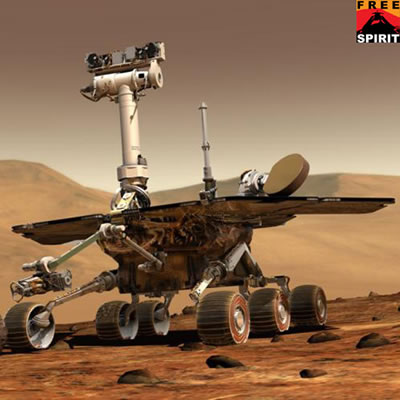Stranded on Mars for Six Years- Spirit Rover - Future Uncertain : NASA
| A brief NASA Video on Spirit's Uncertain Future.Built to Rove for 90 days, NASA's Mars Rover has completed SIx years of roving on Mars. But now it is struck up and unable to move and it power may be Exhausted by Coming "MAY". Though Standing still it is still doing lot of Science |
 |
| An Artistic Concept Showing NASA's Spirit on Mars - Image credit:NASA |
Have you seen the Avatar Movie? Really great Movie - isn't it? In general what I observe is, we humans really like aliens and we have that inherent love for going to other planets, knowing about them. All alien movies are generally set to be box office hits (unless and until the movie is not a complete mess). Finally coming to the point of this write up : "NASA's Mars Rover Has Uncertain Future as Sixth Anniversary Nears"..
NASA's Mars rover "Spirit" will mark six years of unprecedented science exploration and inspiration for the American public on Sunday. However, the upcoming Martian winter could end the roving career of the beloved, scrappy robot. Spirit successfully landed on the Red Planet at 8:35 p.m. PST on Jan. 3, 2004, and its twin Opportunity arrived at 9:05 p.m. Jan. 24, 2004. The rovers began missions intended to last for three months but which have lasted six Earth years, or 3.2 Mars years. During this time, Spirit has found evidence of a steamy and violent environment on ancient Mars that was quite different from the wet and acidic past documented by Opportunity, which has been operating successfully as it explores halfway around the planet.
A sand trap and balky wheels are challenges to Spirit's mobility that could prevent NASA's rover team from using a key survival strategy for the rover. The team may not be able to position the robot's solar panels to tilt toward the sun to collect power for heat to survive the severe Martian winter. Nine months ago, Spirit's wheels broke through a crusty surface layer into loose sand hidden underneath. Efforts to escape this sand trap barely have budged the rover. The rover's inability to use all six wheels for driving has worsened the predicament. Spirit's right-front wheel quit working in 2006, and its right-rear wheel stalled a month ago. Surprisingly, the right-front wheel resumed working, though intermittently. Drives with four or five operating wheels have produced little progress toward escaping the sand trap. The latest attempts resulted in the rover sinking deeper in the soil. "The highest priority for this mission right now is to stay mobile, if that's possible," said Steve Squyres of Cornell University in Ithaca, N.Y. He is principal investigator for the rovers. If mobility is not possible, the next priority is to improve the rover's tilt, while Spirit is able to generate enough electricity to turn its wheels. Spirit is in the southern hemisphere of Mars, where it is autumn, and the amount of daily sunshine available for the solar-powered rover is declining. This could result in ceasing extraction activities as early as January, depending on the amount of remaining power. Spirit's tilt, nearly five degrees toward the south, is unfavorable because the winter sun crosses low in the northern sky.
Unless the tilt can be improved or luck with winds affects the gradual buildup of dust on the solar panels, the amount of sunshine available will
continue to decline until May 2010. During May, or perhaps earlier, Spirit may not have enough power to remain in operation.
"Spirit could continue significant research right where it is," said Ray Arvidson of Washington University in St. Louis, deputy principal investigator for the rovers. "We can study the interior of Mars, monitor the weather and continue examining the interesting deposits uncovered by Spirit's wheels." A study of the planet's interior would use radio transmissions to measure wobble of the planet's axis of rotation, which is not feasible with a mobile rover. That experiment and others might provide more and different findings from a mission that has already far exceeded expectations. In 2004, Opportunity discovered the first mineralogical evidence that Mars had liquid water. The rover recently finished a two-year investigation of a half-mile wide crater called Victoria and now is headed toward Endeavor crater, which is approximately seven miles from Victoria and nearly 14 miles across. Since landing, Opportunity has driven more than 11 miles and returned more than 132,000 images.
Really Spirit standing(roving) boldly upto it's name fought the hostile atmosphere of the Mars for six years, wish it continues it's spirit and
roam on the Mars for coming time and may be so long till it welcomes the First Human setting the Foot on Mars.( Who knows may be you are the one).
To know more about the Mars Rovers Spirit and Opportunity - Click Here (On NASA's Website)
